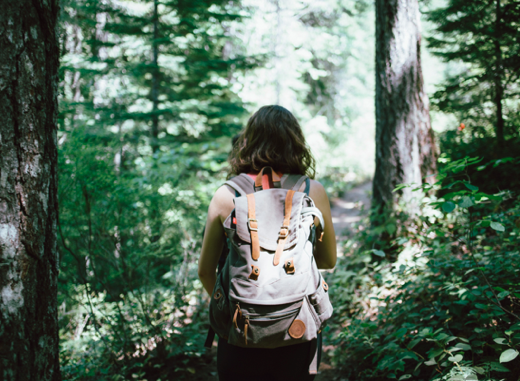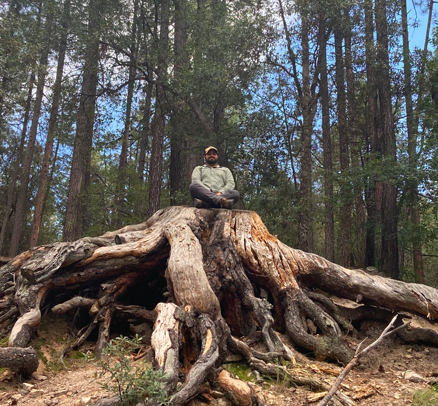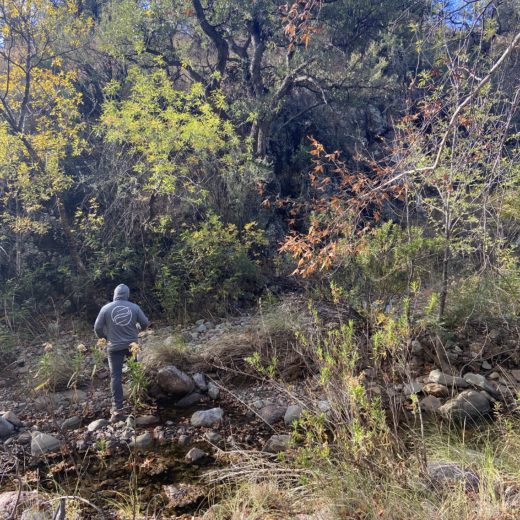Notes from a therapist’s desk…
Parents often prioritize their children’s well-being over their own. Some would argue this is the reality of being a parent. If you’re a regular reader of this blog, you’ll know that we teach the importance of self-care, but also like to acknowledge that effective self-care involves connection and community. Last October, we wrote about the health and wellness benefits nature offers the entire family. We discussed how humans have become removed from nature and how this has impacted children’s and adults’ mental and physical health. This month, we’ll explore how nature and forest therapy can help parents practice self-care.
Self-Care and Community
When parents talk about how they have to sacrifice their well-being for the good of their child, I bring out the airplane analogy. When you are flying on a plane and the oxygen masks drop, caregivers must put their own masks on first, before assisting their child. Because of course, if parents pass out from lack of oxygen, they can’t help the child sitting next to them.
I often tell parents I work with, “A healthy child starts with a healthy parent.” This is true for all parents, whether their child is in therapy or not. Historically, parents have had many supports. The African proverb, “It takes a village,” reminds us that community support is essential when raising a child, not just for the benefit of the child, but also for the success and well-being of parents. As society evolved and families moved away from communal living, our “village” started to shrink, compromising our well-being.
Mending Our Relationship With Nature
Nature can help parents start to feel more connected and supported again. Spending time in nature helps repair our relationship with ourselves, our bodies, the passage of time, community, and the rest of the living world.
Our Relationship with Ourselves
In our day-to-day life we play many roles. We may be a parent, sibling, child, spouse, friend, cousin, and employee or employer. With so many roles and titles we may feel like we wear different masks. This may contribute to a feeling of disconnection with ourselves. Nature invites us to take off our masks and be our authentic ourselves. Next time you go outside and spend time in nature, notice what shifts for you. Pay attention to how you relate to yourself. I wouldn’t be surprised if you find it easier to just to be you.
Our Relationship with Our Bodies
In the Western world at least, we tend to pay attention to our thoughts more than our body sensations. We are told to think rationally when we need to make a decision, rather than ask, “How does my body feel about that?” The phrases, “Go with your gut,” and, “Trust yourself,” remind us to go beyond our thinking selves and step into our bodies’ natural intelligence.
We instinctively listen to our bodies when we become dehydrated, feel thirsty, and reach for a drink. Similarly, when we feel overheated and take break from the sun, we honor our bodies’ wisdom. The same can be said for more complex situations, such as interpersonal interactions. When we talk to someone acting hostile and aggressive, our bodies may start to shake or our hair may stand on end. Our bodies can tell us so much when we simply get out of the way and tune in. Nature can help quiet the mental chatter that tells what we think we need, so we can listen to our bodies’ actual needs instead.
Our Relationship with Time
Have you ever had the thought, “Oh my goodness, is it ___[fill in the holiday]__ already?” Overpacked schedules contribute to our being out of touch with the passage of time. As a result, we develop what might be termed “time amnesia”.
Nature allows us to slow down and rebalance our relationship with time. For instance, when we go camping, we often naturally start to wake up at sunrise and go to bed at sunset, instead of staying up past dark and feeling tired the next day. We rediscover our natural circadian rhythm.
If you are a gardener, you may have a better sense of time than the rest of us, because you work with the land. Learning when to plant certain produce or flowers, and watching plants grow as you tend to them, connects you to the pace of nature.
If you don’t go camping or do gardening, you can begin to repair your relationship with time by simply taking a moment to pay attention to the natural cycles of nature. Try this: Set an intention. The next time you leave home, notice a new flower bud starting to bloom, or watch a leaf change color and fall from the tree.
Our Relationship with Community
Ponder this for a moment: Today’s children have not experienced life without the Internet. They expect to have all the answers at the tips of their fingers, just one Google search away. They know that friends and family are a FaceTime away. They’ve grown up with online learning, Zoom meetings, and of course, social media.
These technical advancements helped bring together groups with similar interests from around the world, but they may have also encouraged us to disconnect from the communities where we live.
When we spend time in nature, we begin to better understand how nature can benefit us, and how the larger community can support us. As a result, we become more likely to give back to the land, and to the community. We may start to cultivate deeper relationships.
Our Relationship with the ‘More-than-Human-World’
Many of us have been taught that being at the top of the food chain makes human beings better than other species. We forget that all living things have a vital role to play. When we spend time in nature, our ‘humans are superior’ mindset may begin to shift.
This shift in perspective helps our relationship with nature and the ‘more-than-human-world’. It also helps us critically examine the roles we play in life. As a result, we may be more apt to put aside a value-based system, and create spaces or spend time in places where all living things are treated with equal importance.

Nature and Forest Therapy
How can busy parents incorporate more nature into their self-care practice? You can participate in a guided nature and forest therapy walk. Nature and forest therapy is a research-based framework for supporting healing and wellness through immersion in forests and other natural environments. It is inspired by the Japanese practice, Shinrin-Yoku, which in English, translates to “forest bathing”.
In this practice, we figuratively “bathe” our senses in the forest, taking in the natural healing properties of the forest. On a nature and forest therapy walk, your body will take in phytoncides, natural chemicals emitted by plants which have been shown to decrease stress and improve immune function. Other health benefits of forest therapy include improved cardiovascular and respiratory health, attention restoration, and a reduction in depression.
Forest therapy follows a defined sequence of guided invitations that provides structure, while embracing opportunities for creativity and serendipity offered by the forest and the inspiration of the guide. A guided walk allows parents to tune into their senses and, “Relax, Restore, Release and Reconnect”.
Why should I use a guide?
While many of the physiological and mental health benefits of nature come from simple exposure to the natural environment, a guide uses their specialized training to help mend the damaged relationships humans have with themselves, their concept of time, their communities, and the more-than-human-world. Trained to work in partnership with the land, a skilled guide can open the door to a deeper and more meaningful experience with nature. Guides can help you tame your mental chatter and embrace the sensations you feel in your body, helping you find yourself in the here and now.
While therapists can be guides, guides are not therapists. The sole aim of a guided walk is to create and sustain opportunities for safe and meaningful relational contact between participants and nature. During guided walks, we like to say, “The forest is the therapist. The guide opens the doors.” If you are ready to try a guided nature walk, or check out the nature and forest therapy resources at the end of this blog.
No guide? No problem.
Not ready for a guided forest therapy walk? Want to find other easy ways to connect to nature for a daily self-care practice? Here are 3 simple ways you can get out of your head and into your heart, with nature…

- Sit Spot: Find a space in nature, somewhere very close to where you live, such as your backyard. The fewer barriers to getting to your sit spot the better. Once you identify a spot, simply sit there for 20 minutes observing your surroundings with all your senses. If you find yourself getting stuck in your head, simply acknowledge your thoughts and allow them to pass. Watch ants move under your feet, listen to bird songs, feel the sun on your skin, smell and taste the air around you. The more you do this practice, the easier it will become to remain present. As you keep going back to the same spot, you will experience the seasonal changes throughout the year. This practice will help you pay attention better in everyday life, decrease stress, support clarity of mind, and repair your relationship with time. No time? Consider this Zen Buddhist saying: “You should sit in nature for 20 minutes a day… Unless you are busy. Then you should sit for an hour.”
- Mindful walks: Taking a walk through the neighborhood or park offers many benefits. However, when we walk sometimes our minds wander and think about the things we have to do or ongoing conflicts we experience, and this can be stressful. Mindful walks provide an opportunity to transform the simple act of walking into a meditation. Before you go for a walk, simply set an intention to observe what you can see around you, what your body feels like when it moves, what sounds you hear, what smells you notice, and what the air tastes like. Walk with all of your senses. If a thought comes up, simply acknowledge it, let it pass, and come back to your senses.
- Nature sounds: Can’t get into nature? Have no fear. Nature’s benefits can come to you! Research shows listening to natural sounds decreases stress and lifts one’s mood. It also creates a quiet space for reflection. Take a break, lie down, and close your eyes as you listen to a recording of sounds from nature. You can try whale sounds, bird song, or other natural sounds that call to you. I recommend doing this for about 20 minutes. You can also use nature sounds if you have trouble falling asleep. Listening to nature sounds decreases racing thoughts and the amount of stress hormones in your body, and allows you to gently enter restorative sleep.
Nature and Forest Therapy Resources
If you are in the Tucson area and want to try a guided walk, check out upcoming events provided by Intuition Trails.
To learn more about the Association of Nature & Forest Therapy (ANFT) click here.
Hope to see you on the trails!
At Intuition Wellness Center, we specialize in health and wellness services for children, young adults, and their families. If you think you would like some extra support, we’re here for you.
Written by: Gabe Rischall, LCSW, nature therapy guide


